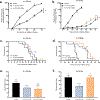Hypofractionated FLASH-RT as an Effective Treatment against Glioblastoma that Reduces Neurocognitive Side Effects in Mice
- PMID: 33060122
- PMCID: PMC7854480
- DOI: 10.1158/1078-0432.CCR-20-0894
Hypofractionated FLASH-RT as an Effective Treatment against Glioblastoma that Reduces Neurocognitive Side Effects in Mice
Abstract
Purpose: Recent data have shown that single-fraction irradiation delivered to the whole brain in less than tenths of a second using FLASH radiotherapy (FLASH-RT), does not elicit neurocognitive deficits in mice. This observation has important clinical implications for the management of invasive and treatment-resistant brain tumors that involves relatively large irradiation volumes with high cytotoxic doses.
Experimental design: Therefore, we aimed at simultaneously investigating the antitumor efficacy and neuroprotective benefits of FLASH-RT 1-month after exposure, using a well-characterized murine orthotopic glioblastoma model. As fractionated regimens of radiotherapy are the standard of care for glioblastoma treatment, we incorporated dose fractionation to simultaneously validate the neuroprotective effects and optimized tumor treatments with FLASH-RT.
Results: The capability of FLASH-RT to minimize the induction of radiation-induced brain toxicities has been attributed to the reduction of reactive oxygen species, casting some concern that this might translate to a possible loss of antitumor efficacy. Our study shows that FLASH and CONV-RT are isoefficient in delaying glioblastoma growth for all tested regimens. Furthermore, only FLASH-RT was found to significantly spare radiation-induced cognitive deficits in learning and memory in tumor-bearing animals after the delivery of large neurotoxic single dose or hypofractionated regimens.
Conclusions: The present results show that FLASH-RT delivered with hypofractionated regimens is able to spare the normal brain from radiation-induced toxicities without compromising tumor cure. This exciting capability provides an initial framework for future clinical applications of FLASH-RT.See related commentary by Huang and Mendonca, p. 662.
©2020 American Association for Cancer Research.
Conflict of interest statement
Conflict of interest
The authors declare no conflicts of interest.
Figures





Comment in
-
News FLASH-RT: To Treat GBM and Spare Cognition, Fraction Size and Total Dose Matter.Clin Cancer Res. 2021 Feb 1;27(3):662-664. doi: 10.1158/1078-0432.CCR-20-4067. Epub 2020 Dec 2. Clin Cancer Res. 2021. PMID: 33268551
References
-
- Delaney G, Jacob S, Featherstone C, Barton M. The role of radiotherapy in cancer treatment: Estimating optimal utilization from a review of evidence-based clinical guidelines. Cancer. 2005;104:1129–37. - PubMed
-
- Rosenblatt E, Izewska J, Anacak Y, Pynda Y, Scalliet P, Boniol M, et al. Radiotherapy capacity in European countries: An analysis of the Directory of Radiotherapy Centres (DIRAC) database. Lancet Oncol. 2013;14. - PubMed
-
- Meyers CA, Hess KR, Yung WKA, Levin VA. Cognitive function as a predictor of survival in patients with recurrent malignant glioma. J Clin Oncol. 2000;18:646–50. - PubMed
-
- Butler JM, Rapp SR, Shaw EG. Managing the cognitive effects of brain tumor radiation therapy. Curr Treat Options Oncol. 2006;7:517–23. - PubMed
-
- Wellisch DK, Kaleita TA, Freeman D, Cloughesy T, Goldman J. Predicting major depression in brain tumor patients. Psychooncology. 2002;11:230–8. - PubMed
Publication types
MeSH terms
Substances
Grants and funding
LinkOut - more resources
Full Text Sources
Other Literature Sources
Medical
Research Materials

